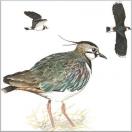Lapwing (or Peewit) - Vanellus vanellus
Typical species of grazing lands and wet meadows, the Lapwing is unmistakable for its multicoloured plumage (black and white from afar) and the long black tuft on its head.
It belongs to a large group of water birds which mostly frequent shallow waters and muddy areas, for which reason they are called "waders".
Sexual dimorphism is not marked, the juveniles can be recognised by their shorter tufts and less contrasting liveries, with the darker parts tending to brown.
Its flight is normally rather slow, but the species is capable of remarkable acrobatics which it performs especially during courtship and to chase away any intruders (including humans) from its territory.
In flight its wings look large and rounded. It often emits a call similar to nasal meows, which explains it popular local Italian name meaning "little pussy cat". It feeds on small invertebrates (insects, molluscs, crustaceans, earthworms etc.).
The nest consists of a small, crude scrape on the ground. On average its lays four eggs. During migration it is very gregarious and sometimes forms mixed groups with the Golden Plover (Pluvialis apricaria).
The east European populations migrate south-westwards to over-winter in the countries surrounding the Mediterranean Basin. A modest number of pairs nest in Italy, mostly in the northern regions.
In Tuscany the Lapwing has been breeding for several years at the Fucecchio Marshes.




